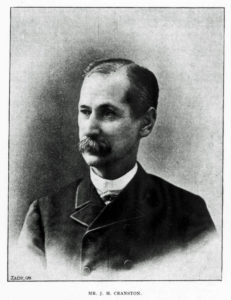 J. H. Cranston was born and educated in the local schools in the seaport town of Mystic, Connecticut. At a relatively young age he became an apprentice at the Reliance Machine Company which specialized in the construction of marine engines. He exhibited an intuitive sense of the design and mechanics of these types of engines which distinguished him from others his own age and older.
J. H. Cranston was born and educated in the local schools in the seaport town of Mystic, Connecticut. At a relatively young age he became an apprentice at the Reliance Machine Company which specialized in the construction of marine engines. He exhibited an intuitive sense of the design and mechanics of these types of engines which distinguished him from others his own age and older.
After a few years he decided to move to Hartford where he was able to find employment as a mechanic on government funded engineering projects. It was during this period of time in the spring of 1861 that the Civil War began. Cranston enlisted in the Union Army and served as a transport engineer during the entire war. At the conclusion of hostilities in 1865, he returned to southeastern Connecticut to resume civilian life. He was soon recruited by a group of business men and investors who were hiring local mechanics for the creation of the Pequot Machine Company. Cranston’s reputation as a stellar mechanic led the investors to offer him the position of supervisor for the new company.
The Pequot Machine Company quickly developed into financially solvent business when it formally contracted with Charles Potter Jr. to construct his established line of commercial printing presses. Cranston not only supervised the day to day assembly of these printing presses but he was able to suggest improvements based on his superior acumen for mechanical design. Many of his ideas for enhancing the mechanical design and function of Potter’s printing presses were incorporated into these machines.
The closing of the Pequot Machine Company a few years later provided the opportunity for J. H. Cranston to start his own printing press manufacturing business. He purchased a factory building in the Thamesville section of Norwich in 1878. Its location and its close proximity to the Thames River and the railway line allowed for shipping the company’s printing presses to their growing numbers of customers. During the next decade the J. H. Cranston & Company received orders for their printer presses from firms in every state in the nation and businesses from around the world. The company’s most popular machine, designed for the printing of newspapers was prized for its workmanship and durability. The J. H. Cranston company claimed that they never had to replace any of their machines due to major equipment failure.
To view images of some of the printing presses manufactured by the J. H. Cranston Company, visit the Otis Library’s Flickr page.

